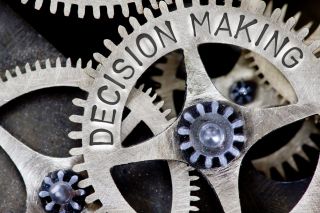Free Will
Do We Have Free Will? How the Brain Makes Decisions
The brain has complex top-down control systems—themselves shaped by many causes.
Updated April 3, 2024 Reviewed by Davia Sills
Key points
- As a physical system, the brain is subject to causal determinants. This seems incompatible with free will.
- Yet, complex top-down control systems render its outputs unpredictable and undetermined by bottom-up inputs.
- Those decision-making systems have biases and proclivities shaped by genes, experience, and learning.
“How did you become a person where that is what you did at that juncture? And the answer is, radically enough, that moment happened because of what came just before that, and what came just before that, and before that, all the way down.”
—Robert Sapolsky1
This is Part 1 of a two-part series.
As a psychiatrist, I am constantly reminded of the constraints on free will. I am struck multiple times a day by the many ways in which people’s ability to control their thoughts, moods, and behaviors is subverted by mental disorders. As a typical patient of mine expressed it: "I just can't control what goes on in my head. I wish I had better control of my thoughts."2
For the most part, mental disorders are not categorically distinct from normal human experience—there is no sharply discernible threshold between normal and abnormal mental experience. Despite this smooth continuum, it is clear that mental disorders frequently reduce a person’s ability to control their mind, whereas those of us fortunate enough to find ourselves in a current state of more-or-less normal mental health (and not intoxicated, sleep-deprived, etc.) would usually insist that we do possess free will—the ability to freely make choices that are not determined for us, impeded, or constrained. Or at least it feels that way.
Yet, acceptance that the mind is the product of the physical brain—and not some free-floating, ethereal entity—would seem to force us to conclude that our thoughts and actions, which are all the product of physical neuronal processes, must be entirely dependent on preceding causes—just like everything else in the universe.3
Determinism—everything is due to preceding causes
The biologist Robert Sapolsky is a hard determinist. He argues that there is no such thing as free will—that there cannot possibly be. While this may be an unappealing idea to most people, it is in many ways the logical and seemingly most consistent conclusion from a scientific perspective and is, in broad principle, the easier position to defend. In his book Determined,4 Sapolsky explains the basis of behavior in terms of its antecedent causes—internal and external, biological and psychosocial, the complex interactions between genes and environment, and how these varied factors ultimately exert their effects on behavior at the neurobiological level.
He delineates a range of proximate and distal causes: seconds before we act (e.g., neurotransmitter signals), minutes to hours before (e.g., the immediate social context), days to months before (e.g., hormonal cycles), years before (e.g., the critical role of childhood experiences and development), centuries and millennia before (e.g., genetics, and also the influence of culture and societal norms, on shaping our instincts and behaviors), all the way back to the evolutionary forces shaping our species’ behavior via natural selection across eons of time.
A scientific argument for free will
Kevin Mitchell is a neurogeneticist who, in his book Free Agents,5 articulates some of the strongest contemporary scientific arguments against determinism and in favor of free will (or, at least, partial free will). Mitchell’s arguments are in many ways less intuitive than Sapolsky’s and more convoluted, so they will require relatively more explanation in these posts to fully appreciate their intriguing but debatable implications.
Mitchell's arguments are based on the complex ways in which high-level decision-making processes in the brain operate. Like Sapolsky, he takes an evolutionary perspective.
The evolution of nervous systems and cognition
Primitive organisms behave in mainly reflexive and mechanistic ways as they respond to stimuli. Their responses are usually based on the value of the stimulus to the organism (good, e.g., an energy source, or bad, e.g., a noxious substance). As animals evolved to become larger, more complex, and more mobile, their nervous systems developed the ability to form complex mental maps or models—internal representations—of the external environment and of their own state and goals. These animals thus had cognitive ability—the ability to form internal representations and to use these to guide behavior.6,7
Delaying responses, cognitive control, and doing things for reasons
Organisms with this capability could delay responses to stimuli and not merely react reflexively and automatically. As their repertoire of potential behaviors expanded through evolution, they had to acquire ways of deciding between actions. Their nervous systems evolved the ability to integrate information from internal representations about their state, goals, and environment and to weigh potential actions based on predicted costs and benefits. This facilitated adaptive behaviors in complex and changing environments. It was an evolution from mere reactive responses to proactive, informed decision-making based on individual needs and reasons. Mammals have this ability more than other animals.
The expansion of the prefrontal cortex in primates, especially in humans, added more levels to the cognitive hierarchy. Humans evolved a unique ability for introspection and abstract reasoning, and through language, the ability to combine ideas in unlimited ways and to express these. Free will requires reflection or metacognition, and conscious cognitive control. Humans have the ability to reason about our reasons and to articulate them to each other and to ourselves.
Noisiness of bottom-up inputs opens the possibility for top-down effects
Mitchell’s argument in favor of free will rests firstly on the argument that the universe is not deterministic at the level of fundamental particles, due to quantum indeterminacy. This introduces an element of randomness in the way particles behave. Secondly, and more relevantly for neurobiological systems, there is a lot of “noise” in the signals transmitted by neurons, which, for the organism, introduces an additional important level of indeterminacy.
Mitchell suggests that the brain exploits and harnesses this indeterminacy or “slack” in the system: The noisiness of bottom-up inputs opens the possibility for top-down effects. It allows the higher order organization of the system to have some constraining influence over the way things happen—the neuronal and behavioral outputs.
This, according to Mitchell, is what confers agency to the organism, allowing it to have some causal effect on its own behavior. He argues that it is the whole organism—the agent, its emergent holistic self—that is doing the decision-making, not just its mechanistic parts.

How neurons make decisions
Neuronal transmission frequently involves a process in which one neuron receives input from multiple other neurons, summing the excitatory and inhibitory input signals to produce an output signal, thus converting all that noisy input into an all-or-nothing binary “decision” to fire or not. Neurons thereby generate new higher-order information by integrating inputs from many neurons. The lower-level information (the input) shapes the output in a probabilistic rather than deterministic manner.
Thus, individual neurons in neural circuits do much more than pass along signals; they actively integrate, transform, and create new information. This process is essential for the brain's ability to make sense of the world, enabling cognitive functions like perception, decision-making, and learning. Mitchell argues that it underpins an organism's capacity to adapt flexibly and make decisions in a dynamic and unpredictable environment, giving it agency.
“Policies” and value in neuronal decision-making
Michael Shadlen is a neuroscientist and neurologist who is an expert on the neural mechanisms of decision-making.8 His lab has studied the specific role of neural noise in decision-making, as well as a key neural mechanism in decision-making that Shadlen refers to as “policy”: a higher-level setting that governs the basic mechanism for converting evidence to a decision—thus controlling the process of deliberation toward a choice. An example of such a policy is the trade-off between the speed and accuracy of a decision.
“Policies instantiate value in the decision process. Speed-accuracy is a special case where the value (or cost) of time is pitted against the value of accuracy […] 9 Of course, like other policies, the speed-accuracy tradeoff is controlled by machinery, and it is established through learning and experiences which are themselves shaped by the agent’s history of exposures and decisions […] Policies are controlled by neurobiology with settings established by the organism’s history, but it is not possible to provide an exhaustive explanation of these settings by looking at the genome, childhood experiences, and so on.”10
If your brain is biased toward favoring speed over accuracy in decisions, then you are inclined toward decisions and actions that are more efficient but also more impulsive. The opposite tendency would be characterized by an inclination toward great caution and perfectionism at the expense of speed.
Genetic predisposition, experience, and learning
Whatever your tendency on that particular continuum and other such continua affecting decision-making, such biases and proclivities are the result of the complex interplay of your genetic predisposition and a lifetime of experience and learning. They define your personality.
We cannot influence our genetic makeup. But can we influence our experience and learning, and if so, how much?
In Part 2 of this two-part series, we will examine the key question of whether we can influence the development of our own biases and proclivities by freely choosing our experiences and our learning, or whether those choices are themselves determined by our predispositions and by circumstances beyond our control.
References
1. Robert Sapolsky vs Kevin Mitchell: The Biology of Free Will | Philosophical Trials #15, moderated by Theodor Nenu, Lecturer in Philosophy at Hertford College, University of Oxford. https://www.youtube.com/watch?v=V9Y1Q8vhX5Y (19:40).
2. Of course, she doesn't experience this feeling all the time, in all her thoughts and actions.
3. A common argument to support the idea that we have some degree of free will in ways that are not completely determined by prior causes, invokes emergent phenomena. These can be hard to define with specificity. Essentially, emergent phenomena refer to complex patterns, behaviors, or properties that arise from the interactions of simpler elements in a system, which are not predictable from the properties of the individual elements alone. Emergent phenomena are observed in systems where the collective behavior of the whole is greater than the sum of its parts.
[Click 'More' to view footnotes 4-10].
4. Robert M. Sapolsky, Determined: A Science of Life Without Free Will (New York: Penguin Press, 2023). See also his previous book, Behave: The Biology of Humans at Our Best and Worst (New York: Penguin Press, 2017).
5. Kevin J. Mitchell, Free Agents: How Evolution Gave Us Free Will (Princeton, NJ: Princeton University Press, 2023).
6. Internal representations have meaning for the organism. They are ultimately grounded in sensory input or motor output, though in their more complex form they may be a few steps removed from these. In complex animals, they can be quite abstract, for example involving categorical semantic concepts.
7. The neuroscientist Joseph LeDoux, who has written extensively on the evolution of cognition, defines cognition as "the ability to use internal representations of information to construct mental models of the world." That is, “the capacity to construct models of the world and use these in thinking, planning, deciding, acting and even feeling.” [Joseph E. LeDoux, The Four Realms of Existence: A new theory of being human (Cambridge, MA: The Belknap Press of Harvard University Press, 2023), p. 138, 165.]
8. Mitchell's ideas about neuronal decision-making are probably influenced by Shadlen's work, though he doesn't explicitly refer to it in Free Agents.
9. Shadlen elaborates: “Other examples of policies would include the relative weighting of different sources of evidence, the value assigned to potential outcomes, temporal discounting of such valuations, the relative contribution to these value functions that reflect group versus self, leverage given to emotional versus empirical considerations, the value assigned to exploration, and so on.” (Shadlen 2014 - reference below)
10. From: “Comments on Adina Roskies, ‘Can Neuroscience Resolve Issues about Free Will?’” Michael N Shadlen. In Moral Psychology, Volume 4: Free Will & Moral Responsibility, edited by Walter Sinnott-Armstrong (Cambridge: MIT Press, 2014). See also: Michael N. Shadlen and Eric R. Kandel, “Decision-Making and Consciousness,” in Principles of Neural Science, ed. Eric R. Kandel et al. (New York: McGraw Hill, 2021), 1392-1415.




